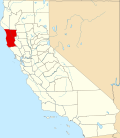This article relies largely or entirely on a single source .(April 2021) |
Ukiah Rancheria | |
|---|---|
| Coordinates: 39°05′25″N123°09′34″W / 39.09028°N 123.15944°W | |
| Country | United States |
| State | California |
| County | Mendocino County |
| Elevation | 636 ft (194 m) |
Ukiah Rancheria is an unincorporated community in Mendocino County, California. [1] It lies at an elevation of 636 feet (194 m). [1]


